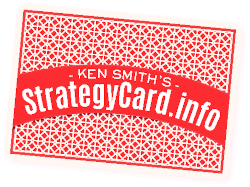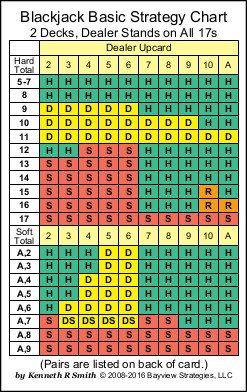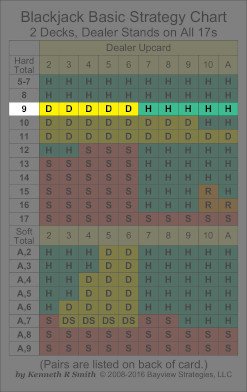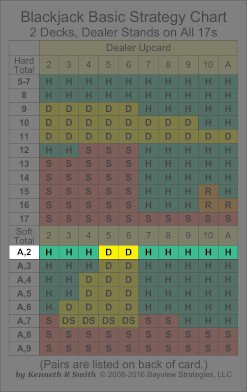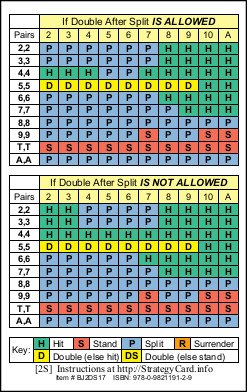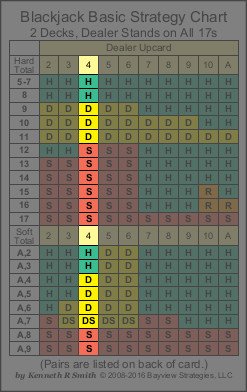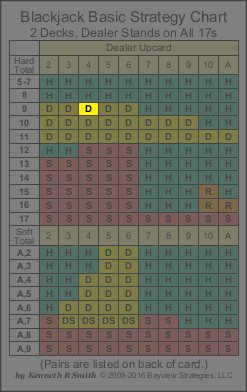Blackjack Basic Strategy Card Instructions
At first glance, these instructions seem pretty involved. But don't worry, you'll find that using the card is actually quite simple.
I've covered a lot of possible questions here. But the reality is that using the card is quite a bit easier than explaining how to use the card!
Step 1: Choose the correct strategy card.
First, determine how many decks are being used at the blackjack game that you choose. In one and two-deck games, it is common for the table signage to indicate how many decks are in play.
For games dealt from a shoe or an automatic shuffler, it is less common for the number of decks to be posted. If you aren't sure, just ask the dealer.
Next, look on the table felt for one of two phrases:
- Dealer Stands on All 17s
- Dealer Hits Soft 17
Now you can choose the correct version of our strategy cards to exactly match the game you are playing.
In the image, you will see the card for a game with two decks, where the dealer stands on all 17s.
Now let's see what happens as you play...
Step 2: Find the correct row for your hand.
Let's say you are dealt the following:
Your Cards:


Dealer Upcard:

Your cards total 9, and there is not an Ace in your hand. Hands without an Ace are called "hard" hands, or "hard" totals. (I'll explain in Step 2A how to handle the soft totals when your hand does include an Ace.)
Look on the card and find the row under "Hard Totals" that is labeled "9".
Look at the provided image of card, and you'll see the row for "hard 9" illustrated.
What if your hard total isn't listed on the card?
That is, if your hard total is less than 5, or more than 17. Well, if it's less than 5, your hand is either a pair (covered in Step 2B), or includes an Ace (Step 2A).
But what about a hard 18? Any hard total that is higher than listed on the card is an automatic "stand". So, if your initial hand totals 18, 19, 20, or 21, just stand.
Step 2A: Dealing with "soft" totals
What if instead, you are dealt this hand:
Your Cards:


Dealer Upcard:

In this case, your hand does include an Ace and your hand is a "soft" total instead. As you can see, the "A,2" row under soft totals is highlighted in the image.
However, there are a couple of tricky details with soft hands, so let me explain a bit.
Remember that an Ace can count as either 1 or 11. If your hand includes an Ace (and doesn't include other cards that total more than 10), then the hand is a "soft" total.
For example, a hand of (Ace,6) is a "soft 17", meaning that it can total either 7 or 17. If you were to hit that hand and draw a ten, now your hand of (Ace,6,Ten) would be a "hard 17", since now the Ace can no longer count as 11 without your hand going over 21.
Last of all, it is important to know how to handle hands with 3 or more cards that include an Ace. If the Ace can still safely be valued as either 1 or 11 without going over 21, then it's still a soft hand.
For example, if your hand is (Ace, 2, 5), that's a "soft 18". On the card, please use the line for "(A,7)" in that case. Just think of the 2 and 5 adding up to 7 to go along with the Ace.
Step 2B: When your hand is a pair
Another difference occurs when your first two cards match in rank:
Your Cards:


Dealer Upcard:

At first glance, this is just a hard total of 16. But, when your first two cards are a pair, you have the possibility of splitting your pair and making two blackjack hands.
That can be the right play, but you'll need to check the back side of the card to be sure. Take a look at the image to see what it looks like.
There are two panels on the back of the card. The top panel is for games where Double After Split is allowed, while the bottom panel is for use in casinos where that rule is not allowed.
Not sure which is the case? Just ask the dealer if you are allowed to double after splitting. (Doubling, as we'll explain later is the ability to double your initial wager and receive one and only card on your hand.)
Because the ability to double after splitting increases the value of splitting some pairs, it impacts the correct strategy of whether to split or not. That's why we have two panels of information for pairs.
Step 3: Choose the column for the dealer upcard.
Step 4: Read the optimal decision from the intersection.
You're done. Read the indicated play from the intersection of the row and column, and that's your optimal play.
For our hand of hard 9 vs a dealer 4, the card shows a yellow square labeled "D".
That means Double Down. Double your wager in exchange for one and only more card being dealt to your hand.
In the long run, you'll make the most money by doubling with hard 9 against a 4 in this game.
Here is an explanation of all the possible strategies indicated on the cards:
That's it. After just a few hands, you'll get the hang of it.
If you don't have your cards yet, visit our Basic Strategy Cards page, and order from Amazon. Thanks!
